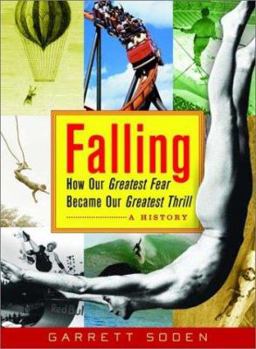Falling: How Our Greatest Fear Became Our Greatest Thrill--A History
Select Format
Select Condition 
Book Overview
A colorful history of purposeful plummeting, from our ancestors in the trees to bungee-jumping. Anyone who has gone over the crest of a roller coaster should wonder why that terror is so much fun. Garrett Soden shows how the act of taking a fall has evolved from a symbol of wickedness in the ancient imagination to the inspiration behind much of today's recreation. Beginning with the tree-climbing lessons of our earliest ancestors, he takes us on a hair-raising tour through the fascinating legacy of nineteenth- and twentieth-century daredevils and madcaps: high-divers who became folk heroes, Niagara Falls tightrope walkers who drew thousands, and parachutists who challenged the "certainty" of suffocation during free fall. Soden draws from these stories the psychological archetype of the gravity rebel, encompassing pioneers in the art from the drunken British carousers who invented bungee-jumping to the California street punks who launched skateboards skyward. In the end we arrive at a fascinating understanding of the mass appeal of today's extreme sports and thrill-seeking technologyfrom roller coasters to virtual reality. 14 b/w illustrations.
Format:Hardcover
Language:English
ISBN:0393054136
ISBN13:9780393054132
Release Date:June 2003
Publisher:W. W. Norton & Company
Length:342 Pages
Weight:1.30 lbs.
Dimensions:1.2" x 6.5" x 8.7"
Customer Reviews
2 ratings
wonderful analisys of sensation sekking sports
Published by Thriftbooks.com User , 17 years ago
This book is amazingly well written, a complex analisys of what people practising sports implying gravity are looking for. The mastering and control, the enjoyment of vertigo: the author explains it all going very deep in the minds of the ones he studied. Wonderful! NOTE: this book is "Falling" of the same author only with a different (less beutiful) title. by c. from italy
Let's Get Down
Published by Thriftbooks.com User , 20 years ago
It is a dream almost everyone has had: you are falling, falling... and then you wake up with a shock. There is even folklore that if you dream that you hit the ground, you die before you wake up (how could anyone tell this?). The universal falling dream is not mentioned in _Falling: How Our Greatest Fear Became Our Greatest Thrill - A History_ (Norton) by Garrett Soden, but the book brightly examines the universality of thinking about falling, fearing it, and enjoying it. The fascination and fear of falling is so basic that it undoubtedly came to us from our arboreal ancestors. We are land animals; if we swim or take to the air, we are doing something unnatural. The time we have been on the ground and walking upright is actually much less than the time we were in the trees. We fear falling, but we get a kick out of a controlled fall, perhaps because controlled falling was necessary as we swung among the trees, and uncontrolled falling was to be avoided. We are newcomers to the flat world, but we carry with us instinctive respect for the power of gravity, and for the kicks it can give us.It is a surprise that a history could be written about falling, but according to Soden, the real history of falling starts in the eighteenth century. Before that time, people were simply terrified of it. Even acrobats stuck basically to the ground and did not fall very far. Not only did people do their best to avoid high falls, they did not for amusement watch others risking high falls. But in the eighteenth century gravity performers became stars. Springboard leapers, mountaineers, and parachutists gave audiences thrills. Many authorities detested that the public liked such things, even though the performers insisted that they were making scientific explorations, not barbarous entertainments. The movies proved to be a fine showcase for falling stunts, and stuntmen became a new profession. Many of the gravity activities have now blossomed into the "Extreme Sports" that are popular with young people. BMX biking, skateboarding, barefoot water-ski jumping, bungee jumping, and free-solo rock climbing (without ropes) all have their adherents, and their place on television. If you lack coordination for such activities, there is always the amusement park. Although much of this book is devoted to "not falling" or at least not getting hurt in doing so, there is also a serious review of risk-taking and what sort of people do it. Research has shown that the "death wish" hypothesized by Freud is simply not working in those who take part in such activities, although it may seem to the rest of us that they are getting excitement by courting death. There are high-sensation types and low-sensation types, but the high-sensation types don't enjoy risk any more than anyone else. For instance, they use such things as seat belts and condoms at the same rate as most people. It turns out that high-risk people who are engaged in such things as free-solo rock climbi





